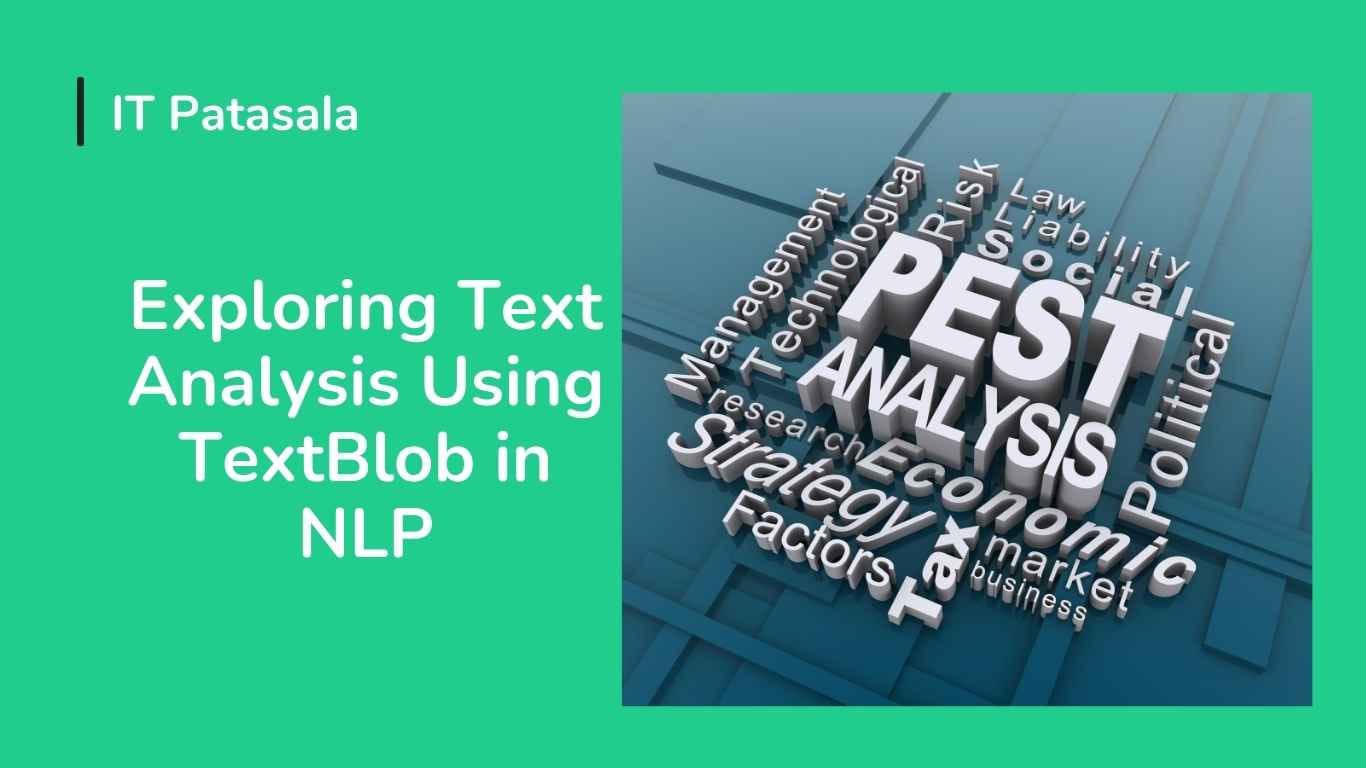Exploring Text Analysis Using TextBlob in NLP | Best 2+ Examples
🧠 Text Analysis Using TextBlob in NLP: A Complete Guide with Examples
Text analysis is one of the most practical and widely used applications in the world of Natural Language Processing (NLP). Whether you’re building a chatbot, analyzing product reviews, or extracting insights from tweets, TextBlob is a powerful yet beginner-friendly Python library that can help you achieve this with ease.
In this post, we’ll explore:
- What TextBlob is
- How it fits into the NLP ecosystem
- Real-time applications of text analysis
- Step-by-step guide to using TextBlob for NLP tasks
- Python examples for sentiment analysis, tokenization, POS tagging, and more
Let’s dive into the world of TextBlob-powered NLP.
📚 What Is TextBlob?
TextBlob is a Python library for processing textual data. It builds on top of NLTK and Pattern, simplifying NLP tasks with a clean and readable API.
Key features:
- Sentiment analysis
- Tokenization
- Part-of-speech tagging
- Noun phrase extraction
- Language translation
- Word inflection and lemmatization
- Spelling correction
⚙️ Why Use TextBlob for Text Analysis?
TextBlob is particularly useful for:
- Beginners learning NLP concepts
- Quick prototyping
- Small to medium-scale projects
- Performing basic NLP without deep ML knowledge
🔍 Installing TextBlob
You can install TextBlob easily using pip:
pip install textblob
After installation, download the corpora:
import nltk
nltk.download('punkt')
🧪 TextBlob Basic Example
from textblob import TextBlob
text = TextBlob("I absolutely love using TextBlob for NLP projects.")
print(text.sentiment)
Output:
Sentiment(polarity=0.625, subjectivity=0.6)
This shows that the sentence is positive and subjective.
💡 Real-Life Applications of TextBlob
💬 1. Sentiment Analysis of Product Reviews
TextBlob helps classify thousands of reviews on platforms like Amazon or Flipkart into positive, negative, or neutral, enabling companies to understand customer satisfaction.
🧑🏫 2. Analyzing Student Feedback
Educational institutions can automate feedback analysis to improve course design and teaching quality.
🐦 3. Social Media Monitoring
Brands can use TextBlob to analyze tweets and determine public sentiment during product launches or PR campaigns.
✍️ 4. Spell Checking and Correction in Editors
TextBlob’s built-in spelling correction can help create smart writing assistants or grammar tools.
🔡 Text Analysis Techniques Using TextBlob
Let’s now explore what you can do with TextBlob step-by-step.
📌 Tokenization: Breaking Text into Words and Sentences
blob = TextBlob("TextBlob is a great tool. It simplifies NLP tasks.")
print(blob.sentences) # Sentence tokenization
print(blob.words) # Word tokenization
Output:
[Sentence("TextBlob is a great tool."), Sentence("It simplifies NLP tasks.")]
['TextBlob', 'is', 'a', 'great', 'tool', 'It', 'simplifies', 'NLP', 'tasks']
🏷️ POS Tagging: Identifying Parts of Speech
blob = TextBlob("TextBlob makes NLP simple and fun.")
print(blob.tags)
Output:
[('TextBlob', 'NNP'), ('makes', 'VBZ'), ('NLP', 'NNP'), ('simple', 'JJ'), ('and', 'CC'), ('fun', 'NN')]
Here, each word is tagged with its corresponding Part-of-Speech.
🧩 Noun Phrase Extraction
blob = TextBlob("Python programming language is versatile.")
print(blob.noun_phrases)
Output:
['python programming language']
This is useful in topic modeling and keyword extraction.
😊 Sentiment Analysis in Depth
TextBlob uses a lexicon-based approach for sentiment analysis. Each word is assigned a polarity and subjectivity score:
- Polarity: -1 (negative) to +1 (positive)
- Subjectivity: 0 (objective) to 1 (subjective)
Example:
blob = TextBlob("The movie was wonderful and the acting was superb!")
print(blob.sentiment)
Output:
Sentiment(polarity=0.85, subjectivity=0.75)
🔄 Language Translation and Detection
blob = TextBlob("Bonjour tout le monde")
print(blob.translate(to='en')) # Translate to English
print(blob.detect_language()) # Detect language
Output:
Hello everyone
fr
Note: You must have an internet connection for translation and detection to work, as it uses Google Translate API.
🔁 Lemmatization and Word Inflection
word = TextBlob("running")
print(word.words[0].lemmatize())
plural = TextBlob("apple")
print(plural.words[0].pluralize())
Output:
run
apples
Useful for text normalization and grammar correction.
✍️ Spelling Correction
text = TextBlob("I relly enjoy writting blogs on NLP.")
print(text.correct())
Output:
I really enjoy writing blogs on NLP.
📊 Real-World Project Example: Analyzing Movie Reviews
Dataset: IMDb or custom scraped reviews
Goal: Classify each review as positive or negative
reviews = [
"I loved the acting and the plot. Great movie!",
"The film was boring and predictable.",
"Amazing cinematography but the story lacked depth."
]
for review in reviews:
sentiment = TextBlob(review).sentiment.polarity
label = 'Positive' if sentiment > 0 else 'Negative'
print(f"Review: {review}\nSentiment: {label}\n")
📈 When Should You Use TextBlob?
✅ Ideal For:
- Educational purposes
- Prototyping NLP apps
- Exploratory text analysis
- Sentiment classification
- Small-scale datasets
❌ Not Ideal For:
- Multilingual NLP
- Context-aware modeling
- High-performance or large-scale ML systems
- Deep learning-based NLP tasks
🧠 Advantages of TextBlob
- Easy syntax and beginner-friendly
- Built-in tools for sentiment, translation, tokenization
- No need for complex training pipelines
- Great for content creators, students, and data analysts
⚠️ Limitations of TextBlob
- Not context-aware (no transformers or deep learning)
- English-focused (other languages are limited)
- Doesn’t handle sarcasm, idioms well
- Less accurate for long and complex text
🔮 Alternatives to TextBlob
If you need more advanced capabilities:
| Tool | Strength |
|---|---|
| spaCy | Fast, efficient, customizable NLP |
| NLTK | Low-level NLP toolkit |
| Hugging Face | State-of-the-art transformer models |
| Flair | Easy-to-use contextual embeddings |
✅ Final Thoughts: Text Analysis Using TextBlob in NLP
If you’re entering the world of text analysis, TextBlob is a perfect place to start. It wraps complex NLP logic in a simple, Pythonic interface, making it easier than ever to:
- Analyze sentiments
- Extract key phrases
- Clean and normalize text
- Even translate across languages!
Whether you’re a student, content writer, or business analyst—TextBlob lets you turn raw text into valuable insights with just a few lines of code.
So go ahead, start exploring your text data, and let TextBlob simplify your journey into NLP.
Also read these




